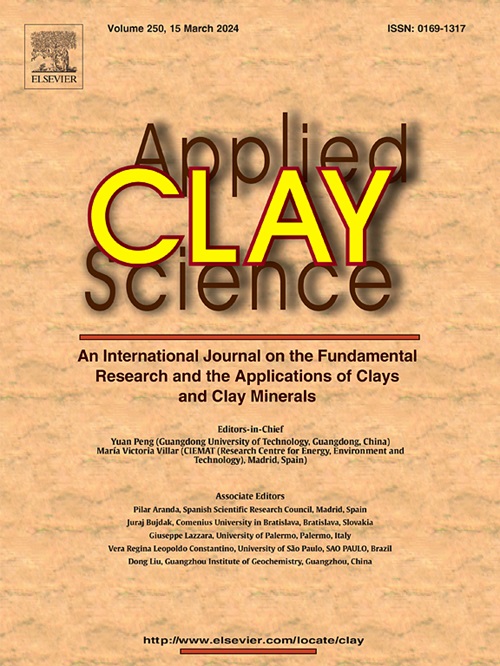古近系近晶粘土加载和卸载过程中微观结构变化和滞后的岩石物理模拟
IF 5.8
2区 地球科学
Q2 CHEMISTRY, PHYSICAL
引用次数: 0
摘要
丹麦古近系富蒙脱石粘土的变形特性与基础设施有关。这些粘土在当地被称为“高塑性粘土”,但当自然固结或在实验室中固结时,很大一部分变形是可逆的。然而,里程表模量不是恒定的,因为卸载-重新加载回路包含明显的滞后。通过使用钻孔声学数据的岩石物理解释方法,本文证明了可逆变形和滞后是如何被解释为应力控制的颗粒接触变化区域,由于每个颗粒表面吸附的水合离子层而导致的颗粒之间的排斥以及应力诱导的水合离子吸附层合并的相互作用的结果。这种吸附层合并具有可逆性和迟滞性,可以解释加载/卸载实验中的迟滞现象。不需要假定的固体颗粒可逆滑动。与迟滞相关的能量反映了离子在合并的吸附层和自由孔隙水之间的传输。本文章由计算机程序翻译,如有差异,请以英文原文为准。
Rock physics modelling of microstructural changes and hysteresis during loading and unloading of Paleogene smectitic clay
The deformation properties of Paleogene smectite-rich clays are of concern in relation to infrastructure in Denmark. The clays are known locally as “high plasticity clays”, but when consolidated naturally or in the laboratory, a significant part of the deformation is reversible. However, the oedometer modulus is not constant, as unloading-reloading loops contain significant hysteresis. By using methods developed for rock physics interpretations of borehole acoustic data, this paper demonstrates how the reversible deformation and hysteresis can be interpreted as the result of an interplay of the stress-controlled changing area of particle contact, repulsion between particles due to the layer of hydrated ions adsorbed on each particle surface, as well as the stress-induced merging of adsorbed layers of hydrated ions. This adsorbed-layer merging is reversible and hysteretic and can explain the hysteresis found in loading/unloading experiments. No supposed reversible slipping of solid particles is required. The energy associated with hysteresis would reflect the transport of ions between the merged adsorbed layers and the free pore water.
求助全文
通过发布文献求助,成功后即可免费获取论文全文。
去求助
来源期刊

Applied Clay Science
地学-矿物学
CiteScore
10.30
自引率
10.70%
发文量
289
审稿时长
39 days
期刊介绍:
Applied Clay Science aims to be an international journal attracting high quality scientific papers on clays and clay minerals, including research papers, reviews, and technical notes. The journal covers typical subjects of Fundamental and Applied Clay Science such as:
• Synthesis and purification
• Structural, crystallographic and mineralogical properties of clays and clay minerals
• Thermal properties of clays and clay minerals
• Physico-chemical properties including i) surface and interface properties; ii) thermodynamic properties; iii) mechanical properties
• Interaction with water, with polar and apolar molecules
• Colloidal properties and rheology
• Adsorption, Intercalation, Ionic exchange
• Genesis and deposits of clay minerals
• Geology and geochemistry of clays
• Modification of clays and clay minerals properties by thermal and physical treatments
• Modification by chemical treatments with organic and inorganic molecules(organoclays, pillared clays)
• Modification by biological microorganisms. etc...
 求助内容:
求助内容: 应助结果提醒方式:
应助结果提醒方式:


